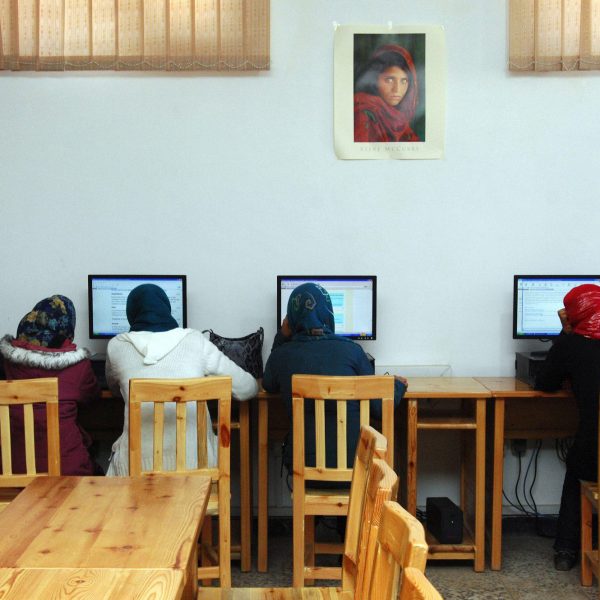An online programme launched by designer and activist Touraj Saberivand has taught design skills to over 1,000 young Afghan women. In this interview, he describes the challenges facing the course and its students.
Saberivand launched the Vand Design Academy after the Taliban took control of Afghanistan in August 2021 and outlawed education for girls after the age of 11.
Offering short courses in graphic design, web design and brand strategy, the programme aims to equip Afghan women and girls with the basic skills needed to become professional designers.
Classes take place online, with each course consisting of eight to 10 sessions.
“We designed a practical course to allow Afghan girls to be able to work as soon as possible,” Saberivand told Dezeen.
“It meant that, after one year, some of them started to get project commissions,” he said.
“Against the government, against political issues, against cultural boundaries, it gave them hope that they could continue their lives, that it wasn’t the end for them.”
Home-based self-employment has become the primary source of income for women in Afghanistan, as the Taliban government has severely restricted their ability to work and travel.
Women are now banned from appearing in public alone and cannot travel further than 72km without a male chaperone related by blood or marriage.
The International Labour Organization estimates that 25 per cent of women in Afghanistan lost their jobs in the first year following the takeover.
This includes an estimated 60,000 women impacted by the state-enforced closure of all beauty salons and a further 4,500 dismissed from jobs in education.
“These girls are active, brave and powerful”
With the Vand Design Academy, Saberivand hopes to broaden the scope of career prospects for young Afghan women.
“It’s a huge step forward,” Saberivand said. “These girls are active, brave and powerful. They want to change their lives and they are struggling for that. Being able to work is a sign that they continue.”
Saberivand runs the design agency Vand International, which specialises in branding design. Although now based in France, he established the studio in his home country Iran, which borders Afghanistan.
Most of the funding for the initiative has come from companies based in Iran, where many are concerned about the political and economic instability caused by the situation in Afghanistan.
A reported 8.2 million Afghan refugees have fled to neighbouring countries since 2021, with an estimated 85 per cent of them in Iran and Pakistan.
The situation became more pressured in November 2023, when Pakistan enforced a policy requiring all undocumented immigrants to leave the country. Over 400,000 Afghans, 80 per cent of them women or children, returned home soon after according to UN Women.
“We never publish their names”
Saberivand made the Vand Design Academy programme available to Afghan women and girls based in their home country and those living abroad.
Over 150 young women attended the course in the first year. More than 800 joined for the second year, bringing the total number of participants to over 1,000.
Attendees included girls as young as 12, with some keeping their participation secret even from their families.
“I tried to keep the girls completely safe,” said Saberivand.
“Some were very visible, posting on Instagram, but some wanted to be hidden,” he explained. “We never publish their names, we never ask them to turn on their cameras and we don’t force them even to talk if they don’t want to.”
Marketing is a key part of the syllabus. Saberivand teaches his students to promote their work through online platforms like Behance, to help them connect with prospective clients.
The fast-track nature of the programme means that many of the students are already earning an income from design.
“I told the girls that, under normal circumstances, people study design for at least four years,” Saberivand said.
“So at the end of one year, you won’t yet be a great designer but you will be able to take on small projects.”
These words have so far proved true. Some students have taken on commissions through Saberivand’s network, while others have found work on their own.
Past students are also helping Saberivand teach the second cohort.
“It’s very complicated because there are girls at lots of different levels,” said Saberivand. “Some of them are ready to be hired, but some of them have no experience of working.”
“We’re teaching software classes in Adobe Photoshop and Illustrator. And we’re teaching them how to communicate and price their projects.”
“The lives of these girls is the focus”
The course faces other obstacles too. Saberivand said many of the students do not have suitable computers. He also has to work around the power outages that for some, particularly in Kabul, have become a daily occurrence.
“It’s hard,” he said. “But we won’t leave this project. We will continue against all the challenges and problems.”
The reward, Saberivand said, is seeing Afghan girls become empowered. He recalled a class where he tasked students with producing a poster about the brave women of this country.
“They were shocked,” he said. “They never dreamed of being brave or powerful. It was really amazing to see their response.”
Saberivand said he is proud to be able to use design as a tool for change.
“Design is not the important matter here,” he added. “For us, it’s the lives of these young, talented girls. That’s the focus.”
The top photo is by Pixabay.
Dezeen In Depth
If you enjoy reading Dezeen’s interviews, opinions and features, subscribe to Dezeen In Depth. Sent on the last Friday of each month, this newsletter provides a single place to read about the design and architecture stories behind the headlines.

